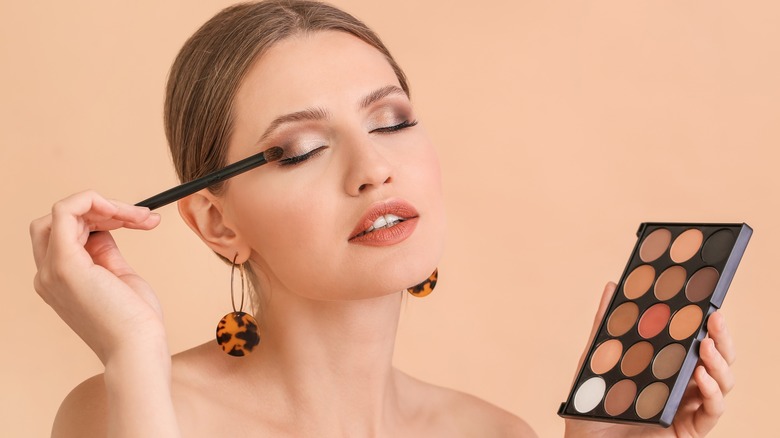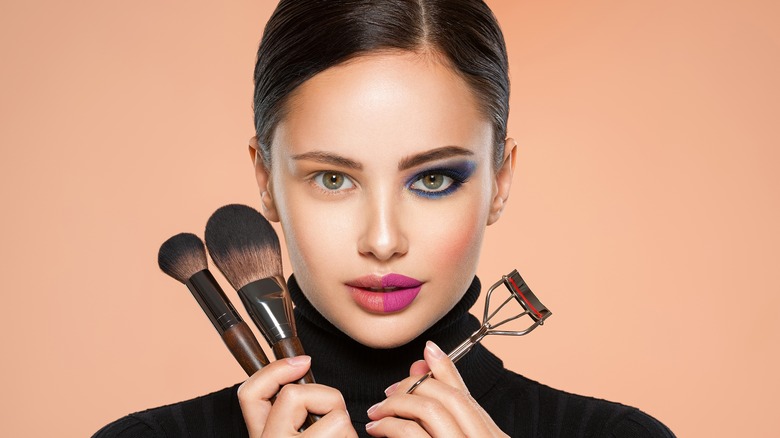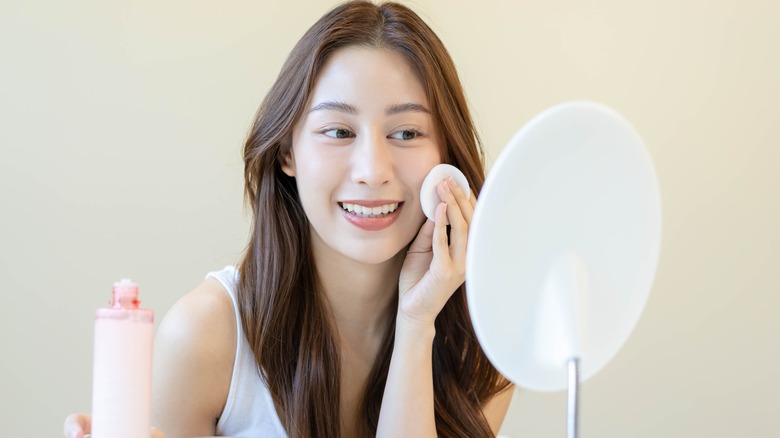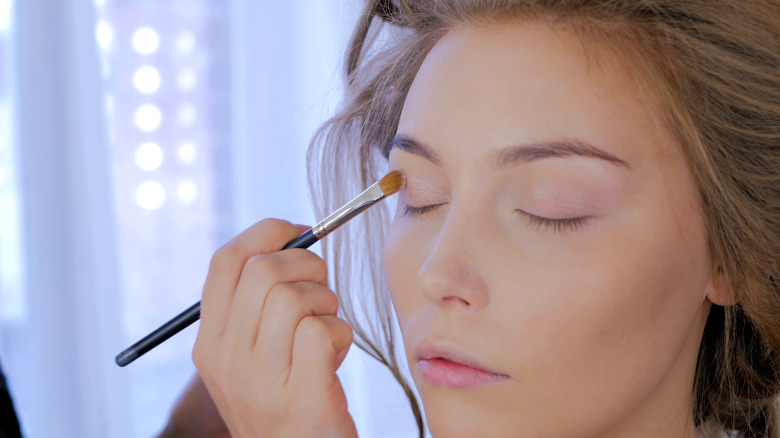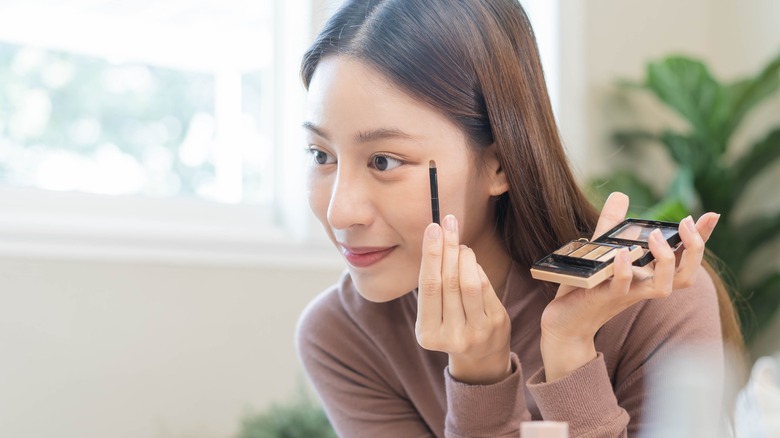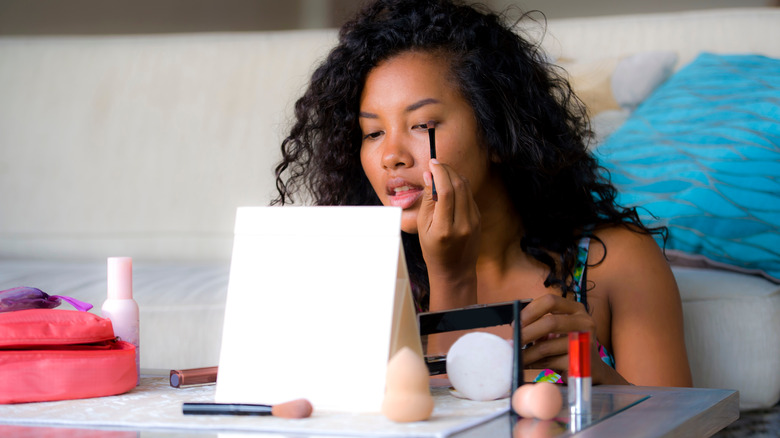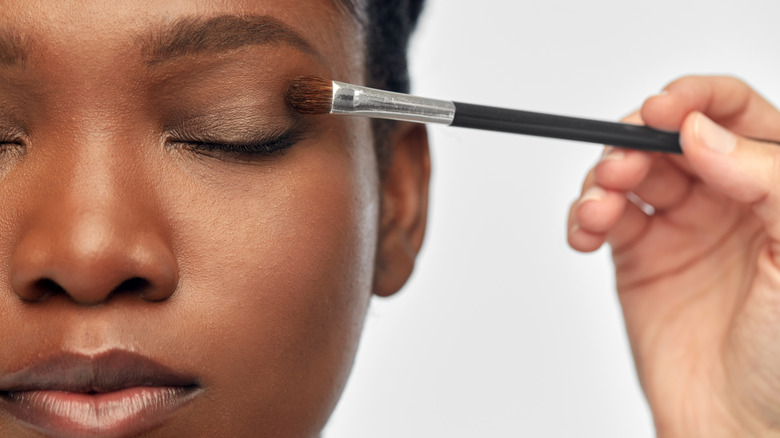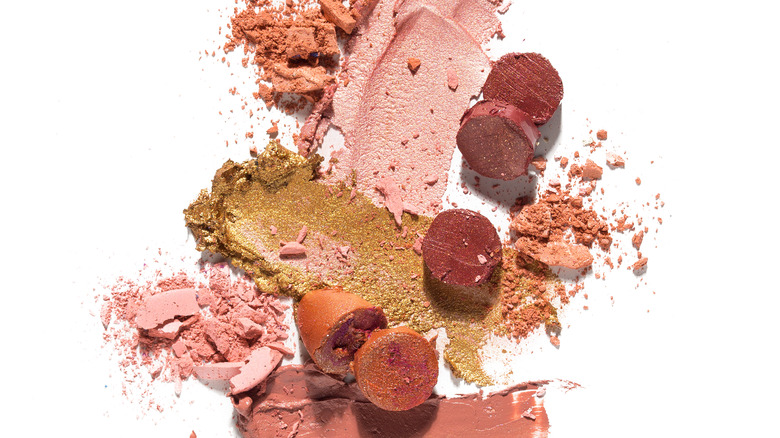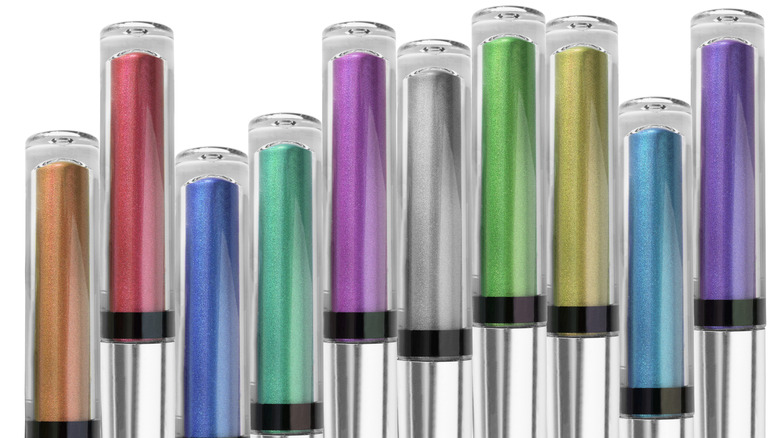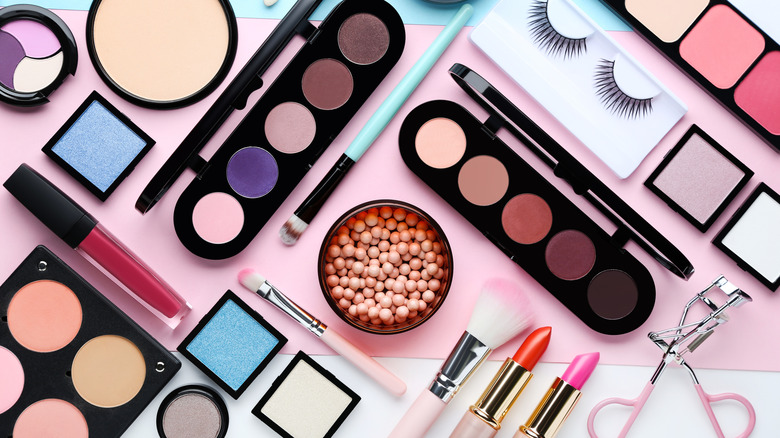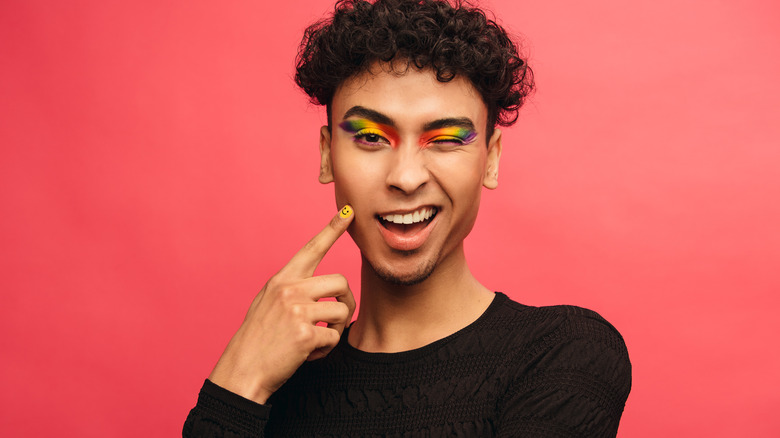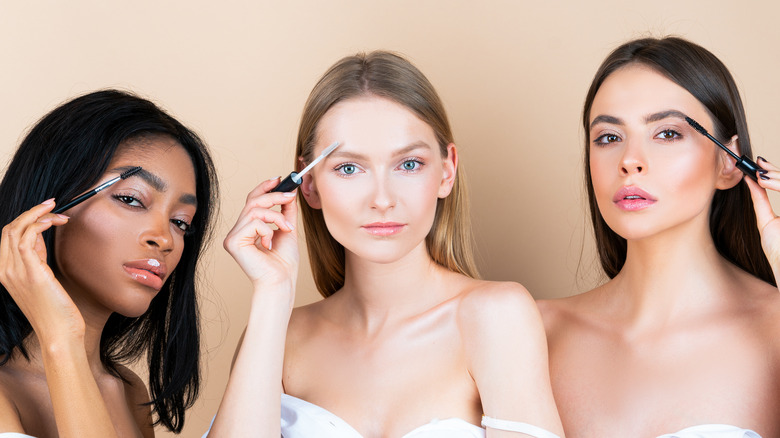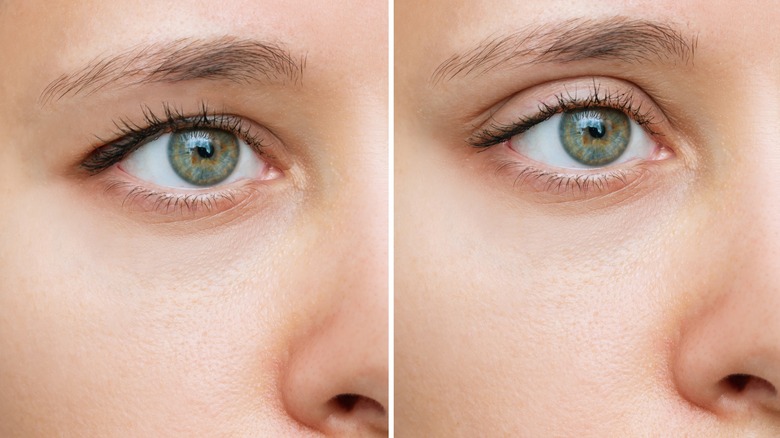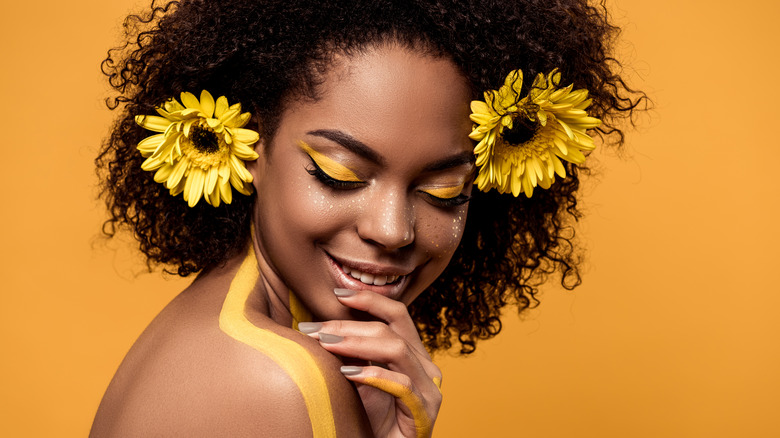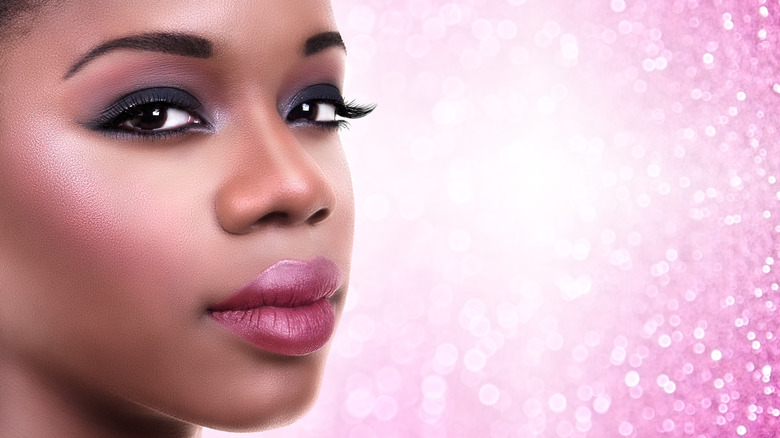All Your Biggest Questions About Eyeshadow, Answered
Whether you love or hate it, eyeshadow isn't going anywhere. People have been wearing this makeup staple for centuries — eye makeup has been a thing since before Cleopatra arrived on the scene, and today there are thousands of products and colors to choose from (via MindBodyGreen).
If you're a makeup enthusiast, your TikTok feed is probably jam-packed with the latest makeup tutorials and trends. Replicating those looks, however, can be harder than those quick tutorial videos make it seem. You're not alone if you want to start playing around with eyeshadow looks but have no idea where to start or even what colors to choose for your skin tone or eyes. Walking down the makeup aisle can feel more than just a little overwhelming, especially if you don't know what you're looking for. Not only are there eyeshadows available in every color imaginable, but there are also different types to choose from — powders, liquids, gels, and even creams are all available options. You can also apply eyeshadow in various ways, depending on the type of eyeshadow you use and the look you're going for — it's a lot, we know.
If you're feeling overwhelmed just thinking about it, fear not. To create a professional look, you don't have to be a makeup artist. Read on as we answer your most burning questions about eyeshadow. We bet you'll be ready to create a kickass smoky eye by the end of it. Let's dive in!
What tools do I need to apply eyeshadow?
Hey, if you've been applying eyeshadow with a rogue makeup applicator or even using your fingers from time to time, we're not going to judge you. If you want to create a professional look, however, you will need the right tools. In this case, makeup brushes.
"The right tools make any job easier, and great makeup brushes are no different," makeup artist Michael Ashton told Ipsy, adding, "A small — but well-curated — collection of brushes will really help elevate your eyeshadow game." You heard the man. Now, you don't have to buy a dozen brushes to get the job done. Ashton recommends you invest in five decent brushes, and you don't have to buy all of them right away. A fluffy domed brush, for example, is a great one to start with because it's a multitasker — it can be used to apply eyeshadow to your whole lid and makes blending a breeze.
Next time you go shopping, invest in a stiff-angled eyeliner brush — it'll help you to create looks that make your lash line pop. A small tapered blending brush is another great addition and helps to blend eyeshadow in the crease of your lid. Another great blending tool is a flat shader brush, which not only works great for blending but can also blend any liner for a smooth look. An angled blending brush, on the other hand, makes blending smaller areas a breeze.
Should I apply eyeshadow before or after putting on makeup?
Most of us have probably asked ourselves this question at some point, and it turns out that there isn't one right answer. According to several makeup artists, it actually all depends on what works best for you and how experienced you are at applying eyeshadow.
"When applying eye shadow, I suggest applying the eye shadow first before you apply foundation to avoid the fallout," celebrity makeup artist Billie Gene told Today. This makes sense. After all, there's nothing worse than trying to create the perfect smoky eye only to end up with dark smudges all over your already made-up face. Claudia Soare, president and creative director of Anastasia Beverly Hills, agrees with Gene. "If you are looking to create a smoky eye or vibrant look then it is a good idea to start with your eyes in case you make any mistakes or have eye shadow fallout," she says.
If you can apply eyeshadow with your eyes closed, however, you can totally go ahead and apply the rest of your makeup first, celebrity makeup artist Desirae Cherman says. As a precaution, she recommends you apply some translucent powder to the area below your eyes. Then, if some eyeshadow does end up on your face, you can simply wipe it off when you're done without ruining your makeup. Sweet!
Do I need to apply a primer beforehand?
You might think that it's not necessary to apply some primer before you start applying eyeshadow, but it can actually make those ten to fifteen minutes you spend in front of the mirror much more worth it.
According to MindBodyGreen, primer isn't a must when you have a quality eyeshadow product and only plan on wearing it for about two hours or so. Any longer than that, however, requires some extra TLC. If you're wearing a full face of makeup for the day, that primer is pretty much a necessity to ensure your eyeshadow doesn't slowly start to wear off. This is especially true during the hot summer months. When attempting bold looks, primer is also essential to ensure they have staying power.
If you don't have an eyelid primer, fear not — your trusty concealer will usually work just fine. Speaking to MindBodyGreen, makeup artist Justyna Santiago said she often applies concealer on her eyelids as a base; you need to make sure you blend it properly, so no extra product sticks around. Apply a translucent powder afterward and start experimenting with a new look.
What is the best way to apply eyeshadow?
Speaking to Today, celebrity makeup artist Mary Irwin said that the most important thing you need to do before you apply eyeshadow is to cleanse your skin properly. Any excess oil on your lids will cause your hard work to be invisible by noon. She recommends using micellar water — it's quick and effective.
Next, you will apply your primer. As for application, mixing light and dark colors always work great, makeup artist Anna Lingis told Glamour. "It's always best to apply a small amount of product then blend and repeat until you have the desired effect, especially if you are a little heavy-handed," she advises, adding that darker shades are much harder to blend properly. So, apply the lightest color to the entire lid and then add splashes of darker shades to your lid's outer crease, then blend it all together. Voila! Just be careful not to blend too much — this will cause a patchy look.
If you want to play with bright colors, makeup artist Huda Kattan has a great tip. "For beginners, be sure to concentrate bright and pigmented shades towards the lashline and center of the lid until you become more confident with shadow placement," she advises, adding that a fluffy blending brush is perfect to even out the look. If you're looking for a more intense color, wet your brush and paste with your eyeshadow before applying it.
How important is blending?
If you thought blending eyeshadow was optional, we're here to tell you that it absolutely isn't. According to Ipsy, people often neglect this step, so if you've been scratching your head trying to figure out what's missing from your eyeshadow game, this is probably it. Blending will help you to "marry as many colors together without being able to see where they start or stop," makeup artist Tai Young says. If you don't blend properly, chances are your eyeshadow usually looks like you experimented with face paint. Blending is the secret sauce to creating a polished and natural look.
Even though so many of us tend to skip this step, it's not that hard to do. Grab your favorite blending brush and gently blend the colors on the outer corner of your eyelid and crease. If you accidentally over blend, add a little bit of color back in. Then blend again if necessary.
Some types of eyeshadow and shades can be harder to blend than others, and if you find that the colors simply won't flow together no matter how much you blend, makeup artist Jeannie Giannone says to take a little bit of translucent powder and use your fluffiest brush to apply it to any stubborn lines. Don't have translucent powder on hand? Use an eyeshadow shade that matches your skin tone instead. Giannone says that applying a bit to the brow bone can help improve that blended look.
How do I find my eyelid's crease?
Knowing where your eyelid's crease is can help you apply eyeshadow like a true pro, and finding it is super easy. Stand in front of the mirror and try to spot the place where your eyelid naturally creases — this is typically the area your eyelids naturally touch when your eyes are open, according to Glamour.
"Looking straight into the mirror and with your eyes open, apply your chosen shade with a brush just above your eyelid. This will guarantee that, whatever your eye shape, you will have shadow that can be seen when the eyes are open," makeup artist Laura Shepherd explains. Defining your crease can really switch up your look, making your eyes look bigger and wider than they are. "You can define your crease by going heavier with a color that's darker than what you used on your lid," makeup artist Tai Young told Ipsy. If you're more into keeping it natural, you can simply use a medium shade that draws attention to that spot without being overdramatic.
What's the difference between powders and creams?
With so many options to choose from, it can be hard to figure out what type of eyeshadow will work best for you. Each has its pros and cons; what you choose at the end of the day will depend on the look you're trying to achieve, your skin type, and your personal preference.
According to Woman & Home, cream eyeshadows can be great for precise application because they're often packaged in crayon form. They're easily blended using cotton buds or even your fingers, so they're perfect if you're a minimalist in makeup. The downside is that creams have less pigment than their powder counterparts, so the look they create will be pretty sheer. Of course, it's perfect if this is what you're into. Just keep in mind that using different shades can get messy and that creams don't last as long as powders, especially if you have oily skin.
On the other hand, powder eyeshadows allow you to play with different colors and have incredible staying power. Not only can you utilize powders to create various looks, but you can also use them as eyeliner if you apply them with a damp, small, pointy brush. The downsides are that powder eyeshadow takes a lot longer to apply. You also need various brushes, and you'll have to watch out for any excess powder on the rest of your face.
What about liquid and glossy eyeshadows?
If you're not into powders or creams, you could consider glossy or liquid eyeshadows. Glossy eyeshadows very much resemble everyday lipgloss — in fact, they're often referred to as lid gloss, according to MindBodyGreen. This type of eyeshadow will give you incredible shine, but there's a catch: it's pretty hard to apply and can easily look like you tried to paint your face. You might also be aware of the gloss on your lids throughout the day if you use a low-quality product. On the flip side, you don't need many tools to apply it well — you can use a brush or even your fingers.
While a gloss provides shine, liquid eyeshadows are known for providing insane color. Their packaging match that of a lip gloss, complete with a similar applicator. While it might seem like applying them could be just as treacherous as glossy eyeshadows, liquid eyeshadows are actually pretty low maintenance. You can control how much you apply with the applicator and even use blending sponges, brushes, or your fingers to create the look you want. The best part? Liquid eyeshadow dries on your lids, making it more likely to stick around all day. Sweet!
How do I spot a quality product?
It can be tricky to know if the eyeshadow palette you're eyeing is worth buying. Typically, you'll only know whether you bought a good product once you use it.
According to BeautyBrainsBlush, the easier the eyeshadow is to blend, the higher the quality of the product. The application will also tell a story — if you find it hard to apply the product evenly despite your best efforts, it's likely that you're not the problem. Eyeshadows that create blotches of color are usually subpar products. Sometimes a bad base can cause this to happen, too, so do some troubleshooting first. Something else to look out for is the pigment. The more pigment, the better the product. Eyeshadow that builds easily is also typically of good quality. If you have to apply several layers to see a hint of color, however, you're dealing with a bad product.
Something else to look out for is the product's staying power. If you apply a quality primer and find that your eyeshadow has disappeared by noon, it's very likely the product isn't that great. A good eyeshadow will stick around all day long. Last but not least, you'd want to pay attention to how the eyeshadow feels on your skin. Cheap eyeshadow products are more likely to cause skin irritation and can even wreak havoc on your eyes. This is because they typically contain more harmful ingredients than their higher-quality counterparts.
How do I choose the right color for my eyes?
Choosing the right eyeshadow palette for your eye color can be a little daunting. After all, how do you know what'll work best if you're not a professional makeup artist? Luckily, picking the right shade isn't nearly as complicated as we all tend to think.
"To enhance your eye color, you want to use shades that are opposite," president and creative director of Anastasia Beverly Hills, Claudia Soare, told Today. "For instance, if your eyes are blue then use warmer shades with hints of orange or coral. If you have brown eyes use blue shades, and if you have green eyes use violet shades," she added. Simple enough, right? Of course, you can experiment and play around to see what you like.
As a general rule of thumb, warm tones work great for people with brown eyes. Think purple, gold, and any other shade that qualifies as "warm." Hazel eyes, on the other hand, work great with green, pink, or purple eyeshadows. Yellow, brown, and gold tones compliment blue eyes the best, while green eyes pop when you use shades of lavender and gold.
How do I choose the right color for my skin tone?
While it's important to choose colors that compliment your eyes, you should also consider your skin's undertone when you're shopping for eyeshadow. If you're wondering how the heck you're supposed to figure that out, fear not, we've got you covered.
According to The Guardian Life, your skin can have one of the following undertones: ashen, yellow, or pink. Depending on which one of these undertones is present, you either have a warm or cool skin tone. If your skin appears to have more of a yellow or golden hue, you have a warm undertone. You have a cool undertone if your skin appears to have a pink or blue hue. If you don't spot any of these hues, you can rest assured that it doesn't mean you're an alien; it simply means your skin has neutral undertones.
Once you figure this out, choosing the perfect eyeshadow palette will be a breeze. If your skin has a warm undertone, opt for colors that complement it, like reds, golds, and oranges. Those with a cool undertone can opt for cool colors, and this includes purples, blues, and greens. If you have a neutral skin tone, you're incredibly lucky and can play around with both warm and cool colors.
How do I use eyeshadow to compliment the shape of my eyes?
How you choose to apply eyeshadow will largely depend on your eye shape, and you can play around with various colors and techniques.
Speaking to Woman & Home, lead artist for NARS, Rachel Hardie, explained that to make your eyes pop, you need to know where to apply different shades. "Using a light tone or shimmery eyeshadow will bring forward and open up. When using dark or matte shades, this can push the area back," she explains, adding that this is basically the secret hack that will help you emphasize your eye shape. "For hooded eyes, I would always apply light on the lid to bring forward, then a darker matte shade on the outer edge to sculpt a shape," Hardie says. If your eye shape is prominent, do the opposite — apply the darker shades to your lid and the lighter shades to the inner corner of your eyelid.
Last, don't forget to apply mascara — this adds definition to your look and helps your eyes pop even more.
Can you use eyeshadow as an eyeliner?
You might not be aware of this, but your favorite eyeshadow can double as an eyeliner, and it's super easy to do too. According to L'Oréal Paris, it's as simple as wetting your finest angled brush under the tap and then dipping it into your favorite eyeshadow palette. The moisture will turn the powder into a paste, making it easy to apply to your eye line. Another option is using a setting spray to wet the brush. If you don't have water or setting spray, eye drops also do a great job. Since eye drops are designed to be safe for the eyes, this is a great option if you're scared of irritation.
Don't have any of the above handy? You can use the eyeshadow just as it is. If it's a creamy eyeshadow, it'll be much easier to achieve the desired look. If you're using a powder, it can still look great; the line will have more of a blurry look.
How can I create the perfect smoky eye?
We all want to create the perfect not-trying-too-hard smoky eye, but it can be easier said than done. Luckily, experts have some tips to make this classic look less daunting. Speaking to MindBodyGreen, makeup artist Gargi Patel explained that three colors are all you need to create this look. "Pick a deep tone like a deep brown/gray/burgundy hue, a highlighter color that is light and shimmery, and a neutral color like a soft pink, light brown, etc.," she says. She adds that you'll need brushes to blend the colors, so make sure you have those on hand.
You'll kick off the process by applying a neutral shade to your eyelid first; then you'll apply the darker shade to your crease — Patel says to work your way in from the outer corner of your eye. Only apply the dark shade to a third of your eyelid, and blend properly. Then you're ready to move on to the next step, which consists of adding some light color above the crease. This time, apply the eyeshadow from the inside of your eye and slowly move outward and upward toward the edge, and voila! Patel says you can also utilize the light color to highlight your brow bone. Hello, effortless smoky eyes!
